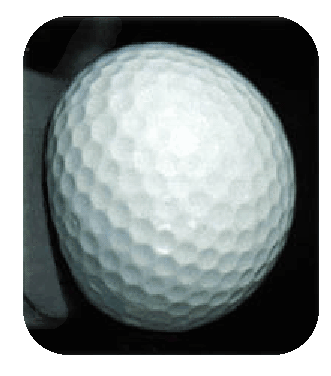|
 The image
to the left shows that a golf ball undergoes compression and is deformed when struck by the face of a club (the
ball is being struck from the left; the club face is light gray in color and to the left of the ball). Notice that at
the point of impact, the ball flattens and more of its surface comes into contact with the club face.
Harder golf balls will have less face contact whereas softer balls will have more. The image
to the left shows that a golf ball undergoes compression and is deformed when struck by the face of a club (the
ball is being struck from the left; the club face is light gray in color and to the left of the ball). Notice that at
the point of impact, the ball flattens and more of its surface comes into contact with the club face.
Harder golf balls will have less face contact whereas softer balls will have more.
Compression is a measure of a golf ball's foot-pound resistance pressure to compressive stresses, or in other
words, the degree to which a golf ball's shape changes when subjected to a compressive load. In the golf ball
industry, compression is rated on a scale of 0 (softest) to 200 (hardest), where each point represents 1/1000th
of an inch of deflection in a ball under load applied by a standard weight. A rating of 200 indicates that the
ball does not compress, whereas a rating of 0 indicates a deflection of 2/10ths of an inch or more. Golf balls
are typically rated 80, 90, or 100 (plus or minus 3-5 points). The construction of a golf ball and the materials
used for its cover, inner layers, and core contribute to a ball's overall rating.
Higher compression-rated golf balls offer greater distance, accuracy, and durability.
These balls come off the club “hotter”, with increased distance both off the tee and
from the fairway. Because harder golf balls do not make as much contact with the
club face as softer balls, they have less “feel” and spin at lower rates, a feature that
provides accuracy, but restricts “shape” shots. High compression-rated golf balls
are for:
- Players whose primary concern is distance.
- Players with slower swing speeds.
- Players who are prone to hook or slice.
- High-handicap players.
Lower compression-rated golf balls offer higher spin rates, greater feel and control.
Because it is softer, the ball remains in contact with the club face longer, which allows
the better player to maneuver the ball around the course. These balls maximize a
player’s ability to work the ball, “shape” shots, and hold greens, however, there is
a small drop in distance, accuracy, and durability, although some have argued that this
is negligible. There have been several published texts to prove that golf ball compression relates more to feel and your own superstition than its performance. The conclusions were, if you take different rated golf balls which have the same construction, aerodynamics, and cover material, and use an automatic golf swing machine such as the Iron Man, the yardage difference between the balls hit were negligible, less than two yards (this information provided by StrictlyGolf). Low compression-rated balls are for:
- Professional and expert players who want the highest level of control off the tee and with the irons,
and who want the softest feel around the greens.
- Players that have consistent and powerful swings.
- “Feel” players and shot-makers.
- Low-handicap players.
In summary, professionals and amateurs with good control may enjoy golf balls rated
at 100, whereas most golfers may be comfortable with balls rated at 80 to 90. Golf
balls below 80 should probably be discarded or sold off as range balls. (Much of this
material was excerpted from “The New Frontier”, by Mike Chwasky, in Golf Tips, June,
1997, p. 72-83).
Back Home...
|

 The image
to the left shows that a golf ball undergoes compression and is deformed when struck by the face of a club (the
ball is being struck from the left; the club face is light gray in color and to the left of the ball). Notice that at
the point of impact, the ball flattens and more of its surface comes into contact with the club face.
Harder golf balls will have less face contact whereas softer balls will have more.
The image
to the left shows that a golf ball undergoes compression and is deformed when struck by the face of a club (the
ball is being struck from the left; the club face is light gray in color and to the left of the ball). Notice that at
the point of impact, the ball flattens and more of its surface comes into contact with the club face.
Harder golf balls will have less face contact whereas softer balls will have more.